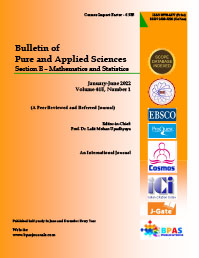AN ANALYTICAL STUDY OF PROCESS PARAMETERS OF PACKAGING FILMS: A CASE OF U-FLEX LTD., NOIDA
DOI:
https://doi.org/10.48165/Keywords:
Packaging Films production process, MSPC, PCA, Pareto diagrams, Hotelling’s T2Abstract
Production and Process Industries’ operations are quite cumbersome. Manufacturing processes tend to produce operational wastages due to various reasons, which can be reduced by identifying and eliminating those reasons. To meet out the customers’ expectations and compliances of business world, vigilance during the production process is inevitable. Quality of Packaging Films produced through complex processes is affected by multiple variables. Traditional Statistical Process Control (SPC) methodologies are non-optimal to monitor and control these multiple variables as the effect of one variable can be confounded with the effects of other correlated variables. Further, the Univariate control charts are difficult to examine and analyze because of the large numbers of control charts of each process variable. An alternative approach is to construct a single multivariate T2 control chart that minimizes the occurrence of false process alarms. This paper studies the application of Multivariate Statistical Process Control (MSPC) charts to monitor packaging film production process in a printing & packaging industry. T2 diagnosis with Principal Component Analysis (PCA) is applied to analyze the critical process variables. Pareto Analysis is performed to identify the critical process variables for minimizing the rejections. Rewinder Tension and Line Tension are found to be the two most critical variables of the production process of packaging films.
References
. Box, G. E., & Kramer, T. (1992). Statistical Process Monitoring and Feedback Adjustment - A Discussion, Technometrics, 34, 251-257.
. Celano, G., Castagliola, P. and Trovato, E. (2012). The Economic Performance of a CUSUM Control Chart for Monitoring Short Production Runs, Quality Technology & Quantitative Management, 9(4), 329-354.
. Cervone, H.F. (2009). Managing digital libraries: the view from 30,000 feet, applied digital library project management-using Pareto analysis to determine task importance rankings, OCLC Systems and Services: International Digital Library Perspectives, 25(2), 76-81.
. Chandna, P. and Chandra, A. (2009). Quality Tools to Reduce Crankshaft Forging Defects: An Industrial Case Study, Journal of Industrial and Systems Engineering, 3 (1), 27-37.
. Henneberg , M., Jørgensen, B. and Eriksen, R.L. (2016). Oil condition monitoring of gears onboard ships using a regression approach for multivariate T2 control charts, Journal of Process Control, Vol.46, Oct 2016, 1-10.
. Hossen, J., Ahmad, N. and Ali, S.M. (2017). An application of Pareto Analysis and cause-and-effect diagram (CED) to examine stoppage losses: a textile case from Bangladesh, The Journal of the Textile Institute, 1-9, Issue Mar 2017.
. Hotelling, H.H. (1947). Multivariate quality control illustrated by the air testing of sample bombsights, Techniques of Statistical Analysis, 111-184.
. Joshi, A. and Kadam, P. (2014). An application of Pareto Analysis and Cause Effect Diagram for Minimization of defects in Manual Casting Process, International Journal of Mechanical And Production Engineering, Vol. 2, Issue- 2, Feb.-2014, 36-40.
. Karuppusami, G. and Gandhinathan, R., (2006). Pareto analysis of critical success factors of total quality management, The TQM Magazine, 18(4), 372-385.
. Kourti, T. (2005). Application of latent variable methods to process control and multivariate statistical process control in industry, International Journal of Adaptive Control and Signal Processing, 19, 213– 246.
. Li, J., Jin, J., and Shi, J. (2008). Causation-Based T2 Decomposition for Multivariate Process Monitoring and Diagnosis, Journal of Quality Technology, 40, 46–58.
. Mason, R.L. and Young, J.C. (2001). Implementing multivariate statistical process control using Hotelling’s T2 statistic, Quality Progress, 34(4), 71-73.
. Perzyk, M. (2007). Statistical and Visualization Data Mining Tools for Foundry Production, Foundry Commission of the Polish Academy of Sciences, 7 (3), 111 – 116.
. Rama Mohana Rao, O., Venkata Subbaiah, K., Narayana Rao, K. and Srinivasa Rao, T. (2013). Application of Multivariate Control Chart for improvement in Quality of Hot Metal - A Case Study. International Journal for Quality Research, 7(4), 623-640.
. Shao, Y.E., Lu, C.J., and Chiu, C.C. (2011). A Fault Detection System for An Autocorrelated Process using SPC/EPC/ANN AND SPC/EPC/SVM Schemes, International Journal of Innovative Computing, Information and Control, 7(9), 5417-5428.
. Sparks, R. (2015). Monitoring Highly Correlated Multivariate Processes Using Hotelling's T2 Statistic: Problems and Possible Solutions, Quality and Reliability Engineering International, Vol. 31, Issue 6, 1089-1097.
. Sharaf El-Din, M.A., Rashed, H. I. and El-Khabeery, M.M. (2006). Statistical Process Control Charts Applied to Steelmaking Quality Improvement, Quality Technology & Quantitative Management, 3(4), 473-491.
. Shewhart, W.A. (1931). Economic Control of Quality of Manufactured Product, Van Nostrand Company, New York.
. Talib, F., Rahman, Z. and Qureshi, M.N. (2011). Pareto Analysis of Total Quality Management Factors Critical to Success for Service Industries, International Journal of Quality Research, Vol. 4, Issue 2, 155-168.
. Yang, H.H., Huang, M.L. and Yang, S.W. (2015). Integrating Auto-Associative Neural Networks with Hotelling T2 Control Charts for Wind Turbine Fault Detection, Energies 2015, 8(10), 12100- 12115; doi:10.3390/en81012100.
. Zhang, G., and Chang, S. (2008). Multivariate EWMA control charts using individual observations for process mean and variance monitoring and diagnosis, International Journal of Production Research, 46(24), 6855-6881.
. Zhang, J., Li, Z., and Wang, W. (2010). A multivariate control chart for simultaneously monitoring process mean and variability, Computational Statistics and Data Analysis, 54, 2244-2252.
